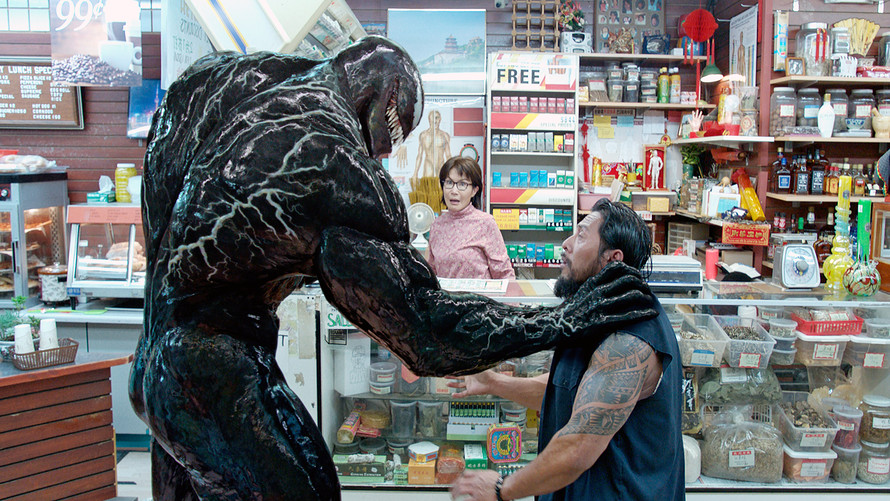
‘It’s our job to figure out how to highlight what the director intends for audiences to experience,’ said 4DPLEX art director Daniel Yi
There’s a scene in the trailer for Sony’s SNE, +0.28% “Venom” where the alien symbiote emerges from Eddy Brock’s arm, black and slimy, and proceeds to speak with him.
It’s a disturbing prospect, but Daniel Yi, the art director at CJ 4DPLEX, is focused on one thing: How would a person experience that in real life? That’s what he ponders every day at his job.
CJ 4DPLEX’s signature creation, 4DX, has been touted as a way for moviegoers to actually “experience” the films they watch. In some ways similar to an immersive theme park ride, 4DX auditoriums feature moving chairs, wind and fog machines, rain makers and different scents that waft into the space depending on the scene.

It’s Yi’s job to make sure the audience has an exciting but seamless movie-viewing experience. And it’s not always an easy job.
In the case of “Venom,” which hits theaters Friday, Yi and his team had less than two weeks to figure out what 4DX elements — chair vibrations and punches, air sprays, gunpowder and burning rubber smells, to name a few — to include in the 4DX version of the movie and how to match them up with the movie’s plot.
For any 4DX-destined movie, the first thing the team does is watch the whole film once to get a general feel for it. Then they discuss what sort of movie this is — is it highly emotive or is it mostly action? What are the characters like? How can 4DX best serve this type of film?
They then break the movie down, section by section, and add in the various 4DX elements. To avoid falling prey to roller coaster-like gimmicks, Yi’s team needs to make sure the final product is high-impact but nuanced — a harder task than one might think, especially given the short time frame.
For instance, when there’s a busy action sequence, the team needs to pick and choose what to focus on. “You can’t put in chair vibration and a shot of air and fog and everything else that’s going on,” said Yi. “It becomes too much for our bodies to understand.”
“It’s our job to figure out how to highlight what the director intends for audiences to experience,” he said. That means selecting what effect will accentuate that part of the story best.
Then there are the tricky bits unique to each movie. In “Venom,” the symbiote takes over Brock’s body, enveloping him from the inside out. A moviegoer obviously won’t experience what it’s actually like to be taken over by a giant parasite, but Yi’s team has figured out ways to enhance what the audience sees on the screen, he said.
In one scene, Brock is stuck underneath a car, his left leg broken. Venom envelopes the broken leg, jerking it back into place—here, the 4DX chair jerks suddenly—and the black, oozing gunk moves up to wrap over the rest of Brock’s body, the sensation accentuated by a low vibration throughout the chair.
During one bit where Venom springs out of Brock’s right arm, moviegoers will feel a jab in their own right arm, courtesy of their chairs. To enhance scenes featuring Venom slithering across a surface, those same chairs will sway gently side-to-side to bring out that slinking effect.
After the team has put all the 4DX pieces together, the movie studio sends executives — and sometimes the film’s director — to watch the movie in 4DX, after which they give feedback and Yi makes final tweaks.
When asked what changes were made in the case of “Venom,” Yi demurred. The company has confidentiality agreements with studios when it comes to those details to avoid leaking any important plot points, CJ 4DPLEX said.
A subsidiary of Korean holding company CJ Group’s 001040, +0.38% cinema division, CJ 4DPLEX launched its technology in South Korea in 2009 before expanding stateside in 2010. There are now 562 theaters around the world that show 4DX films, with 10 so far in the U.S.
The future of 4DX hangs on the assumption that moviegoers want to actually experience movies, not simply watch them. It’s a daring concept — and an expensive one, with each auditorium costing $1.2 million to $1.4 million to build, according to CJ 4DPLEX — but it’s clear some exhibitors see potential in the idea. Chains like Cineworld’s CINE, -0.76% Regal Entertainment Group and Cinépolis USA have signed on in the U.S., sharing building costs with the company and giving it a cut of the ticket sales.
“We believe that going to the movies is a more holistic experience than simply sitting in front of the screen to enjoy a film,” Cinépolis USA’s Chief Executive Luis Olloqui said in an email, adding that Cinépolis sees a promising future in immersive moviegoing. The chain operates two 4DX theaters in the U.S. and has more projects lined up, he said.
Regal has seven locations in the U.S. that feature 4DX, with 78 more coming in the next several years, according to Regal’s Chief Marketing Officer Ken Thewes. “We continue to receive positive feedback from our guests” about 4DX, he told MarketWatch in an email.
4DX admissions in the U.S. are skyrocketing, according to numbers provided by CJ 4DPLEX, even as general admissions fall. Domestic 4DX admissions have increased by more than 10-fold in the past few years, going from just 37,232 in 2014 to 422,232 in 2017.
The company’s immersive technology could be one of the keys to getting audiences back into the theater in the age of Netflix and Hulu, said Yi.
“We are giving audiences something they can’t get at home — a way to watch that’s a visceral experience,” he said.


